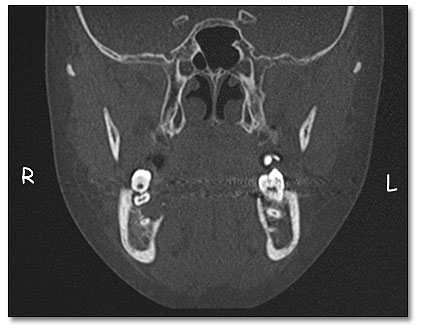Return to Case of the Month Archives
A Rapidly Growing Swelling in the Right Posterior Mandible
Dolphine Oda, BDS, MSc
doda@u.washington.edu
Contributed by
Drs. Mark Egbert, Rafael Alcalde & Tarja Kaakko
Seattle Children’s Hospital & University of Washington
Case Summary and Diagnostic Information

This is an 11-year old Hispanic female who presented with a rapidly growing swelling in the right posterior mandible of one month’s duration with significant displacement of teeth. There was no history of trauma.
Diagnostic Information Available
This is an 11-year old Hispanic female who presented at the University of Washington Pediatric Dentistry clinic with a rapidly growing swelling in the right posterior mandible, area of teeth #s 30 and 31, of one month’s duration with significant displacement of teeth. There was no history of trauma.
The past medical history is unremarkable. There was no family history of related disease.
Clinical examination revealed a firm, pink, fleshy mass in the right posterior mandible
with focal areas of erosions covered by pseudomembrane. The mass also displaced teeth numbers 30 and 31.
As shown in the photograph at the right, a pink, sessile swelling is visible. It is expanding buccally and lingually with focal areas of red and white on its surface. It is displacing teeth #s 30 & 31.

Multiple radiographic images—panoramic, periapical (not shown) and computed tomography (CT) scan were taken and all revealed an expansile and destructive soft tissue lesion with cortical perforation. The panoramic image is show below shows bone resorption in the right mandible in the area of teeth #s 30 & 31.

A CT scan revealed that the lesion extended into the floor of mouth and posteriorly into the lateral oral pharynx near the lingual nerve.

An incisional biopsy was initially performed on the day of presentation. Four days after the incisional biopsy, the patient presented with a larger lesion with a non-healing or fungating biopsy site (Figure 4).

Figure 4.
Within one week, the lesion was completely excised.
Histological examination reveals a highly cellular fibrous lesion with a focal myxoid background. The fibroblasts are eosinophilic with plump and vesicular nuclei and are arranged in elongated fascicles with focal areas of storiform pattern as shown below.
The lesion infiltrates the adjacent structures, including bone, muscle and surrounding connective tissue. Mitotic figures are present but scant. There is no evidence of pleomorphism.

Figure 5. Low power (x100) histology shows fibroblasts arranged in elongated fascicles with focal areas of storiform pattern.

Figure 6. High power (x200) histology shows fibroblasts arranged in elongated fascicles.
The surgical specimen was interpreted at Children’s Hospital by Dr. Kathy Patterson; the histology of the surgical specimen is similar to that of the incisional biopsy. Immunohistochemistry markers are positive with smooth muscle marker HHF35, but negative with desmin, myogenin, and S-100 proteins. The IHS marker profile combined with the H&E stain are consistent with aggressive fibromatosis.
After you have finished reviewing the available diagnostic information